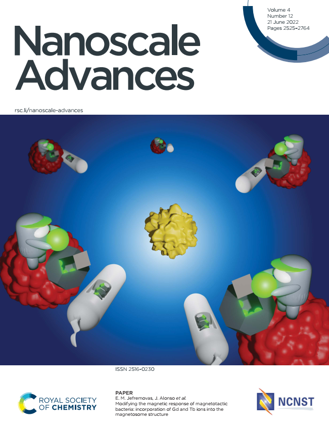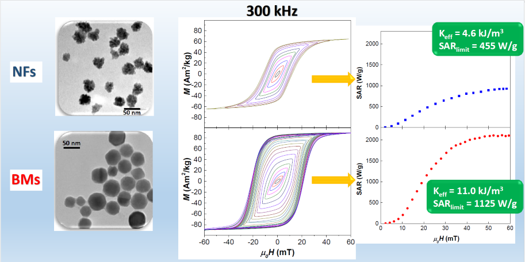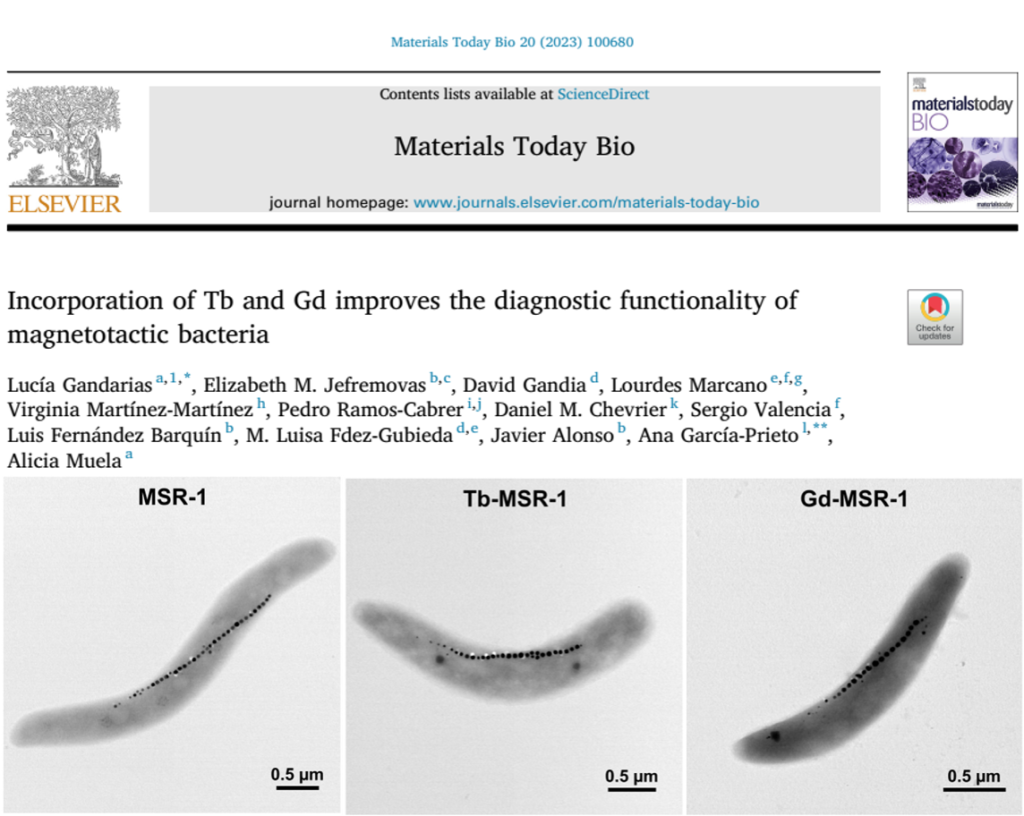
Antiferromagnetic materials are receiving renewed interest on behalf of their potential for
information technologies. Recent reports have also revealed how the physics governing such
magnetic arrangements and their excitations become more complex compared to traditional
ferromagnetic materials, especially at the nanoscale. Here, we address two main issues that
are of prime interest to their technological transfer. First, using small-angle neutron scattering, we show the existence of a magnetic helix-like super-structure in a polycrystalline
TbCu2 alloy, preserved at both bulk and nanoparticle ensembles of 8 nm. Second, using
inelastic neutron scattering, we elucidate the magnetic excitons and the crystalline electric
field energy level schemes of TbCu2 in bulk and nanoparticle ensembles.
Incorporation of Tb and Gd improves the diagnostic functionality of magnetotactic bacteria
Junio 2023
Magnetotactic bacteria are envisaged as potential theranostic agents. Their internal magnetic compass, chemical environment specificity and natural motility enable these microorganisms to behave as nanorobots, as they can be tracked and guided towards specific regions in the body and activated to generate a therapeutic response. Here we provide additional diagnostic functionalities to magnetotactic bacteria Magnetospirillum gryphiswaldense MSR-1 while retaining their intrinsic capabilities. These additional functionalities are achieved by incorporating Tb or Gd in the bacteria by culturing them in Tb/Gd supplemented media. The incorporation of Tb provides luminescence properties, enabling potential applications of bacteria as biomarkers. The incorporation of Gd turns bacteria into dual contrast agents for magnetic resonance imaging, since Gd adds T1 contrast to the existing T2 contrast of unmodified bacteria. Given their potential clinical applications, the diagnostic ability of the modified MSR-1 has been successfully tested in vitro in two cell models, confirming their suitability as fluorescent markers (Tb-MSR-1) and dual contrast agents for MRI (Gd-MSR-1).

Molecular Bridge Engineering for Tuning Quantum Electronic Transport and Anisotropy in Nanoporous Graphene
3
Paper published in Journal of the American Chemical Society (JACS)
A new NPG structure where such chemical knobs are introduced and where the interribbon coupling strength can be additionally modulated by a continuous conformational transformation of the molecular bridges. The interribbon electronic coupling can be controlled by the different degrees of freedom provided by phenylene bridges that couple the conducting channels. This versatility arises from the multiplicity of phenylene cross-coupling configurations, which provides a robust chemical knob, and from the interphenyl twist angle that acts as a fine-tunable knob.
The capability of manipulating the interphenyl twist angle is experimentally inferred from the subtle interplay between the steric hindrance and substrate interactions that leads to different twist angles in individual ribbons and NPGs with different bridge configurations. This is further corroborated by the researchers using ab initio calculations where the effect of substrate interaction is directly addressed and the energetics of the twist angle are quantitatively analyzed. Electron propagation simulations demonstrate the capability of either switching on/off or modulating the interribbon coupling by the corresponding use of the chemical or the conformational knob.
The synthesis of atomically precise nanoporous graphene structures consisting of graphene nanoribbons connected by flexible phenylene bridges opens a way of tailoring quantum transport and the anisotropy in 2D materials. Calculations demonstrate that para bridges can be designed to tune this anisotropy continuously in a wide range by varying the interphenyl twist angle. This could be modulated by external stimuli such as strain or electric fields applied to functionalized polar phenylene bridges or more statically by using substrates with different degrees of interactions.
Molecular bridges therefore emerge as efficient tools to engineer quantum transport and anisotropy in carbon-based 2D nanoarchitectures. This strategy could also be used to tailor the phononic anisotropy, leading to novel approaches in the search of thermoelectric nanomaterials.

Atomically Sharp Lateral Superlattice Heterojunctions Built-in Nitrogen-doped Nanoporous Graphene [+]
Paper published in Advanced Materials
A synthetic strategy to fabricate nanometer scale, coherent lateral superlattice heterojunctions with atomically sharp band discontinuity is reported. By merging interdigitated arrays of different type of graphene nanoribbons by means of a novel on-surface reaction, superlattices of one-dimensional, chemically heterogeneous nanoporous junctions are obtained.

Modifying the magnetic response of magnetotactic bacteria: incorporation of Gd and Tb ions into the magnetosome structure
Paper published in Nanoscale Advances
May magnetotactic bacteria and rare earth (RE) ions get along with each other? Definitely, yes. In this work we have successfully doped magnetosomes synthesised by magnetotactic bacteria Magnetospirillumgryphiswaldense with Gd3+ and Tb3+ ions. The magnetic properties of the doped bacteria get altered by the substitution of Fe3+ ions by those RE3+. This boosts the potential applications of magnetotactic bacteria in the biomedical and theragnostic field.

Spin dynamics in magnetic nanoparticles
PhD. Thesis, E. M. Jefremovas
The Thesis work studies the spin dynamics in ensembles of magnetic nanoparticles, where the magnetism arises from 4f (GdCu2, NdCu2, TbxR1-xCu2) and 3d (γ-Fe2O3, Fe3O4) orbitals. The analisis of a rich variety of magnetic order and disorder states provides a deep understanding on the fundamentals beneath the interactions among the magnetic moments.

Observation of surface magnons and crystalline electric field shifts in superantiferromagnetic NdCu2 nanoparticles
Paper published in Physical Review B
Check out our work on NdCu2 nanoparticles. Thanks to the use of Inelastic neutron scattering, we have been able to observe the crystalline electric field splitting, and the magnon excitations, in these 4f ensembles of nanoparticles. We have also been able to observe such excitations taking place at the nanoparticle surface, which is unprecedent in 4f ensembles of nanoparticles.

Nanoflowers Versus Magnetosomes: Comparison Between Two Promising Candidates for Magnetic Hyperthermia Therapy
Paper published in IEEE
Magnetic Fluid Hyperthermia mediated by iron oxide nanoparticles is one of the most promising therapies for cancer treatment. Among the different candidates, magnetite and maghemite nanoparticles are on top due to both their performance and their biocompatibility. Nonetheless, up to date, the literature comparing the heating efficiency of magnetite and maghemite nanoparticles of similar size is scarce. To fill this gap, here we provide a comparison between commercial Synomag Nanoflowers (pure maghemite) and bacterial magnetosomes (pure magnetite) synthesized by the magnetotactic bacterium Magnetospirillum gryphiswaldense of <D> ≈ 40–45 nm. Both types of nanoparticles exhibit a high degree of crystallinity and an excellent degree of chemical purity and stability. The structural and magnetic properties in both nanoparticle ensembles have been studied by means of X–Ray Diffraction, Transmission Electron Microscopy, X–Ray Absorption Spectroscopy, and SQUID magnetometry. The heating efficiency has been analyzed in both systems using AC magnetometry at several field amplitudes (0–88 mT) and frequencies (130, 300, and 530 kHz).
Please visit this link to see full list of published papers [+].


